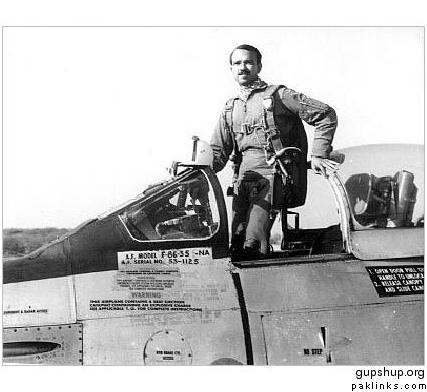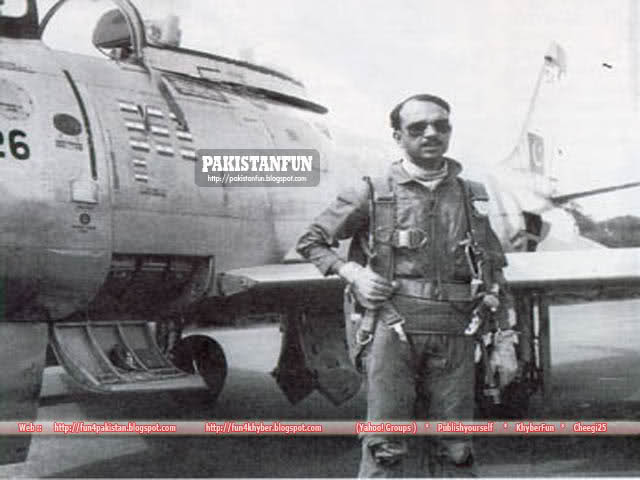رد: رقم قياسي عالمي- تدمير 5 طائرات خلال 1 دقيقه. حرب 65 طيار باكستاني محمد محمود عالم
بعث سجل باكستان ، عقد طيران مقاتلة كرجل جديد : Mohmammad M. العالم
في منتصف عام 1965 هو بلا شك نقطة الذروة للقوات الجوية الباكستانية في 54 سنة من تاريخها. أنها سلطت الأضواء على الطابع الأساسي لهذه القوة الجوية عندما واجهت بلا هوادة ، لأول مرة ، مع كامل نطاق المواجهة مع العدو رقم واحد ، وسلاح الجو الهندي.
محمد محمود العالم ، الذي ولد في عام 1935 في ولاية بيهار والبنغال الغربية ، هي حتى الآن هداف الفريق طيار من القوات الجوية الباكستانية. في حرب عام 1965 ، واسقطوا تسع طائرات هندية (خمسة في طلعة واحدة) ودمرت اثنين اخرين. بتاريخ 6 سبتمبر 1965 ، خلال معركة جوية فوق أراضي العدو ، وأصيب قائد السرب محمد محمود علام ، في طائرة من طراز اف 86 سيبر جت ، بانخفاض اثنين هنتر طائرات العدو ودمرت ثلاثة آخرين. لاستثنائية تحلق المهارة والشجاعة التي أظهرها هذا قائد السرب ، علام منحت سيتارا - ط Juraat [ونجمة الشجاعة]. يوم 7 سبتمبر 1965 ، ان العالم اليوم هو ان العراق دمر خمس طائرات العدو هنتر في أقل من دقيقة ، الذي لا يزال رقما قياسيا لهذا اليوم. عموما كان تسعة ويقتل اثنين من أضرار على الائتمان.
ومن الجدير نقلا عن الكاتب الهندي هنا من كتابه Fiza'ya ، بخصوص هذا الانجاز الرائع من مدبولى علام : "إن الادعاء على اسقاط خمس الصيادون في غضون 30 ثانية من قبل قائد السرب مدبولى علام قائد السرب رقم 11 (اف 86F) ، إذا كان هذا صحيحا ، سيكون وهو عمل غير مسبوق في تاريخ الطيران الطائرات الحربية ، وربما في تاريخ كل الحروب الجوية. فتوافا ان طيارا في الحرب العالمية الثانية ، اسقطت خمس طائرات السوفياتي في طلعة جوية واحدة ، ولكن لا أحد (باستثناء مدبولى العالم) يمكن أن يدعي خمسة في غضون أقل من دقيقة. "
وفقا لملم العالم اليوم نفسه ، وهو الآن رجل تغيرت. بعد ترقيته الى قائد الجناح ، وقال انه باغان على السؤال وتصحيح أسلوب حياته ، وتوصل الى استنتاج بأن التخلي عن القيم الإسلامية التقليدية من جانب القوات الجوية الباكستانية تشكل خيانة للشعب وخدم. الرمز الأكثر وضوحا من أن الإخلال بالقيم وكان استهلاك الكحول. العالم اليوم ليس فقط إنهاء الممارسات غير الأخلاقية وغير اسلامية مثل بنفسه ، وإنما أيضا أخذت زمام المبادرة لاقناع زملائه على القضاء على الكحول من مطعم الضباط. ليس من المستغرب أن العالم المتنامية الحماس للإسلام أحبطت العديد من ضباط القوات الجوية الباكستانية ، جيدة وكثير منهم من رؤسائه.
العالم في عام 1979 أخذ إجازة وتسللوا عبر الحدود إلى أفغانستان. وهو يعتقد أن العالم اليوم نصحت وألهمت المجاهدين في أفغانستان في عملياتها ضد الحكومة المدعومة من الاتحاد السوفيتي في أفغانستان. منذ عودته إلى باكستان من الجهاد ضد الملحدين السوفياتي ، حياة العالم قد تغير. بدأ يعيش حياة البساطة ، ويقيم في شقة مفروشة قليلة في كراتشي مع أكثر قليلا ثم كومة من الكتب.
ومن المثير للاهتمام أن نلاحظ أنه خلال ظهوره على التلفزيون الباكستاني مع زميل له من قدامى المحاربين في حرب عام 1994 ، محطما بذلك مرة واحدة ايس من باكستان أدلى عدد قليل جدا من الملاحظات حول انجازاته الرائعة وقت الحرب ، وهو أمر يدل على طبيعته جديدة متواضعة وسلمية. "وكانت تلك آخر ، في وقت سابق محمد علام ،" العالم اليوم كما اعترف بنفسه في هذه المقابلة. والواقع أن هذا العالم الجديد هو رجل مختلف ، أكثر انشغالا من سلامته الروحية مع بتمجيد اعماله معارك قديمة.
في هذا اليوم الدفاع عن باكستان ، وينبغي لنا شرف وأشيد بهذه صادقة والله واعية الرجل ، ليس فقط لأنه أظهر شجاعة كبيرة في حرب عام 1965 وعلى معالم أخرى في القوات الجوية الباكستانية الوظيفي له ، ولكن أيضا لشجاعته في التخلي عن حياته المرموقة ، وعلى جهوده في إزالة الممارسات اللاأخلاقية في القوات الجوية الباكستانية.
http://www.yespakistan.com/memorialday/... MMAlam.asp
The rebirth of Pakistan's record-holding Air Fighter as a New Man: Mohmammad M. Alam
The middle of the year 1965 was unquestionably the peak point of the Pakistan Air Force's 54-year history. It brought into focus the fundamental character of this relentless air force when faced, for the first time, with a full scale confrontation with its number one enemy, the Indian Air Force.
Mohammad Mahmood Alam, who was born in 1935 in the state of Bihar, Western Bengal, is so far the top scorer fighter pilot of PAF. In the war of 1965, he shot down nine Indian planes (five in one sortie) and damaged another two. On September 6, 1965, during an aerial combat over enemy territory, Squadron Leader Mohammad Mahmood Alam, in an F-86 Sabre Jet, shot down two enemy Hunter aircraft and damaged three others. For the exceptional flying skill and valor displayed by this Squadron Leader, Alam was awarded Sitara-i-Juraat [The Star of Courage]. On September 7, 1965, Alam is said to have destroyed five more enemy Hunter aircraft in less than a minute, which remains a record to this today. Overall he had nine kills and two damages to his credit.
It is worth quoting an Indian author here from his book Fiza'ya, regarding this remarkable achievement of M. M. Alam: "The claim of shooting down five Hunters within 30 seconds by Squadron Leader M. M. Alam OC No. 11 Squadron (F-86F), if true, would be a feat unprecedented in the annals of jet air warfare, probably in the history of all air warfare. A Luftwaffe pilot in WWII downed five Soviet aircraft in a single sortie, but no one (except M. M. Alam) could claim five in the space of less than a minute."
According to M. M. Alam himself, he is now a changed man. After his promotion to Wing Commander, he bagan to question and rectify his lifestyle, and reached the conclusion that the abandonment of traditional Islamic values by the PAF constituted a betrayal of the people it served. The most obvious symbol of that compromise of values was the consumption of alcohol. Alam not only quit such immoral and unIslamic practices himself, but also took the initiative to persuade his colleagues to banish alcohol from the officers' mess. Not surprisingly, Alam's growing zeal for Islam frustrated many PAF officers, a good many of whom were his superiors.
In 1979 Alam took a leave of absence and slipped over the border into Afghanistan. It is believed that Alam advised and inspired the Mujahiddin of Afghanistan in their operations against the Soviet-backed Afghan government. Since his return to Pakistan from the Jihad against the Soviet atheists, Alam's life has changed. He began to live a life of simplicity, residing in a sparsely furnished apartment in Karachi with little more then a pile of books.
It is interesting to note that during his appearance on Pakistan Television with his fellow war veterans in 1994, this once dashing Ace of Pakistan made very few remarks about his brilliant war time achievements, which is quite indicative of his new humble and peaceful nature. "That had been another, earlier Mohammad Alam," as Alam himself admitted in this interview. Indeed this new Alam is a different man, more concerned with his spiritual integrity than with glorifying his old dogfights.
On this Defence Day of Pakistan, we should honor and pay tribute to this honest and God-conscious man, not only for the great courage he demonstrated in the 1965 war and for the other landmarks in his PAF career, but also for his courage in giving up his prestigious life and for his efforts in removing immoral practices in Pakistan Air Force.
http://www.yespakistan.com/memorialday/ ... MMAlam.asp














